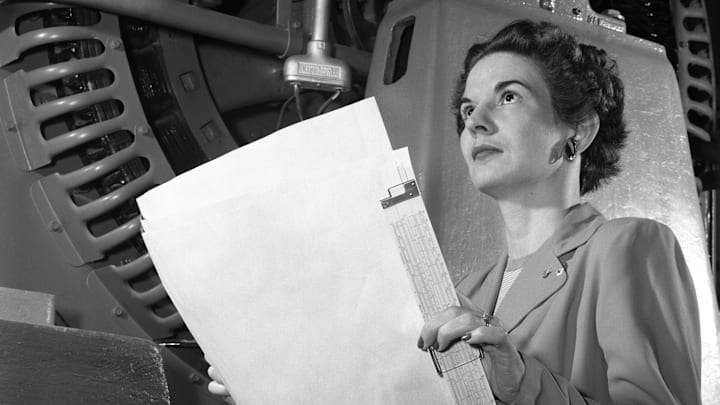In her 32 years working for NASA, Kitty O’Brien Joyner helped usher its wind tunnels into the space age and proved that electrical engineering wasn’t just for men. In fact, her career actually predated NASA itself. Learn more about the organization’s first woman engineer below.
1. Kitty O'Brien Joyner's father inspired her interest in engineering.
Kitty O’Brien Joyner was born Kitty Wingfield O’Brien in Charlottesville, Virginia, on July 11, 1916. Her father, Edwin K. O’Brien, was an engineer, credited with patenting a “device for inserting explosive charges in Earth” in 1917. As a kid, she looked up to her father and even wished she were a boy so she, too, could become an engineer.
2. Joyner originally thought she’d develop items in the domestic sphere.
While attending Sweet Briar College, an all-women school in Virginia, one of Joyner’s professors encouraged her to pursue engineering. Joyner did, but she was a realist about what her opportunities might be as a woman. “Her interest is principally in the field of lighting and she feels that a woman, combining technical skill and natural intuition, is in a better position to design lights and household appliances than men,” The Miami Daily News reported in a 1938 feature on her.
3. She sued the University of Virginia to gain admission to its engineering program.
After graduating from Sweet Briar in 1937, Joyner decided to go for an electrical engineering degree at the University of Virginia’s engineering school—an all-male institution that she had to sue in order to be admitted. When she finished her degree in 1939, she became the school’s first-ever woman graduate. (She wasn’t, however, its first-ever woman student. Ella Mae LeSueur had attended in the late 1920s, but left to marry one of the instructors, Lawrence R. Quarles, before graduating.)
4. Joyner was a standout student.
During her time at UVA, Joyner distinguished herself as one of the program’s best and brightest. In November 1938, she was one of just six students chosen to present research papers at the American Institute of Electrical Engineering’s southern district convention in Miami. Joyner’s report, “Fluorescence, the Light of the Future,” won the second-place prize, behind a University of Tennessee student’s paper called “Calibrating Frequency Matters.”
Joyner’s presence was noteworthy enough to earn her more than one news mention. “Virginia Girl Student Wins Engineers’ Prize,” Richmond, Virginia’s The Times-Dispatch reported. “Girl Engineer Talks,” read The Miami Daily News’s headline. The following year, UVA presented Joyner with the Algernon Sydney Sullivan Award, given to students “honored for their service to the campus community and the community at large.”
5. She was the first woman engineer hired at NASA’s Langley Research Center.
In September 1939, Joyner was hired to work in the Langley Memorial Aeronautical Laboratory (now called Langley Research Center) at the National Advisory Committee for Aeronautics, the precursor to NASA. She was Langley’s first-ever woman engineer; her official job title was “junior civil engineering aide.”
6. Joyner became one of Langley’s branch heads.
Joyner didn’t stay an aide forever. She climbed the ranks at the lab, and in 1962 even became the head of the “facilities cost estimating branch” in Langley’s Office of Engineering and Technical Services.
7. Joyner’s focus was mainly on wind tunnels.
During her time at Langley, Joyner helped create the electrical systems for wind tunnels. These tubular passages simulate flight conditions so researchers can test aircraft, spacecraft, and other equipment to see how they will perform during a real-life mission. Joyner worked on supersonic wind tunnels, which circulate air faster than the speed of sound.
8. She married a fellow NASA employee.
Not far into her career at Langley, Kitty met a physicist named Upshur T. Joyner, and the two tied the knot in September 1941. Upshur’s area of expertise was in aircraft landing; a couple of notable studies co-written by him include “Considerations on a Large Hydraulic Jet Catapult” and “Effects of Pavement Texture on Wet-Runway Braking Performance.” Upshur was a branch head at Langley, too, at the “landing and impact branch” in the Dynamic Loads Division. The Joyners had two kids: Upshur (who also became an engineer) and Kate.
9. Joyner was an active member of the United Daughters of the Confederacy.
The United Daughters of the Confederacy was founded in 1894 by white Southern women who wanted to commemorate and honor Confederate soldiers. The organization was hugely influential in popularizing what’s known as the “Lost Cause” mythology of the Civil War—the idea that the Confederacy heroically fought to protect states’ rights, and that protecting slavery was a minor (or even nonexistent) motivation. It also trivialized the horrors of slavery, mythologized the antebellum South, and cultivated white supremacy.
In 1992, Joyner was awarded the UDC’s Winnie Davis medal (named for the daughter of Confederate president Jefferson Davis), given to members who far exceed their required responsibilities. The exact details of her contributions to the organization are unclear.
10. Joyner was a big fan of joining organizations.
The UDC wasn’t the only organization Joyner took part in. She was a member of the Institute of Electrical and Electronics Engineers; the Engineers Club of the Virginia Peninsula; and the P.E.O. (Philanthropic Educational Organization) Sisterhood, which helps promote educational opportunities for women.
She also joined the Daughters of the American Revolution and the National Society Daughters of the American Colonists. Since both institutions require members to prove that their lineage dates back to colonial America, Joyner’s ancestors must have immigrated to the U.S. before it was even the U.S.
11. Joyner died in 1993.
Kitty and Upshur Joyner both retired from NASA in 1971 and both died in 1993. Kitty passed away first, at age 77, on August 16; her husband followed less than three months later, on November 9, at age 85.
